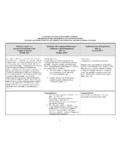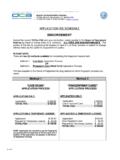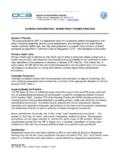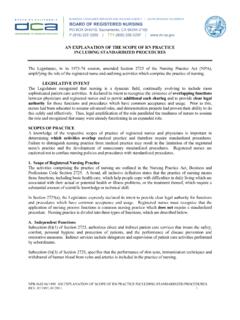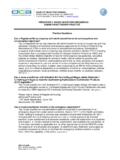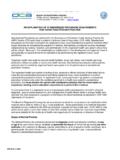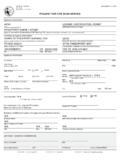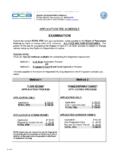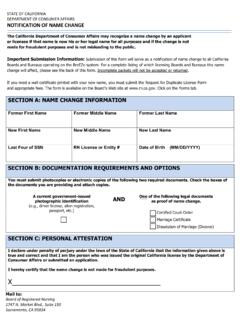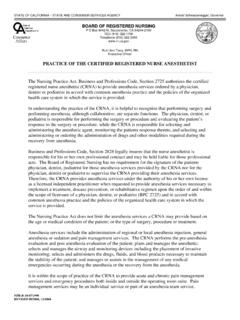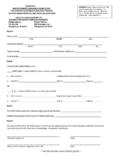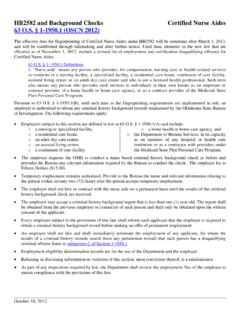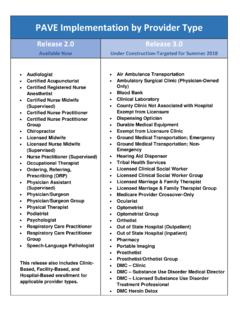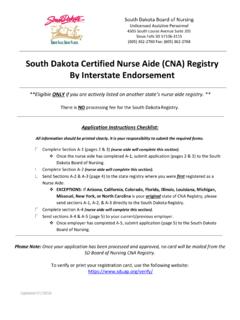Transcription of CALIFORNIA NURSING PRACTICE ACT
1 BUSINESS, CONSUMER SERVICES, AND HOUSING AGENCY GOVERNOR EDMUND G. BROWN JR. BOARD OF registered NURSING . PO Box 944210, Sacramento, CA 94244-2100. P (916) 322-3350 F (916) 574-8637 | CALIFORNIA NURSING PRACTICE ACT. Website: Scope of Regulation Excerpt from Business and Professions Code Division 2, Chapter 6. Article 2. Section 2725. Legislative intent: PRACTICE of NURSING Defined 2725. (a) In amending this section at the 1973-74 session, the Legislature recognizes that NURSING is a dynamic field, the PRACTICE of which is continually evolving to include more sophisticated patient care activities. It is the intent of the Legislature in amending this section at the 1973-74 session to provide clear legal authority for functions and procedures that have common acceptance and usage. It is the legislative intent also to recognize the existence of overlapping functions between physicians and registered nurses and to permit additional sharing of functions within organized health care systems that provide for collaboration between physicians and registered nurses.
2 These organized health care systems include, but are not limited to, health facilities licensed pursuant to Chapter 2 (commencing with Section 1250) of Division 2 of the Health and Safety Code, clinics, home health agencies, physicians'. offices, and public or community health services. (b) The PRACTICE of NURSING within the meaning of this chapter means those functions, including basic health care, that help people cope with difficulties in daily living that are associated with their actual or potential health or illness problems or the treatment thereof, and that require a substantial amount of scientific knowledge or technical skill, including all of the following: (1) Direct and indirect patient care services that ensure the safety, comfort, personal hygiene, and protection of patients; and the performance of disease prevention and restorative measures. (2) Direct and indirect patient care services, including, but not limited to, the administration of medications and therapeutic agents, necessary to implement a treatment, disease prevention, or rehabilitative regimen ordered by and within the scope of licensure of a physician, dentist, podiatrist, or clinical psychologist, as defined by Section of the Health and Safety Code.
3 (3) The performance of skin tests, immunization techniques, and the withdrawal of human blood from veins and arteries. (4) Observation of signs and symptoms of illness, reactions to treatment, general behavior, or general physical condition, and (A) determination of whether the signs, symptoms, reactions, behavior, or general appearance exhibit abnormal characteristics, and (B) implementation, based on observed abnormalities, of appropriate reporting, or referral, or standardized procedures, or changes in treatment regimen in accordance with standardized procedures, or the initiation of emergency procedures. (c) "Standardized procedures," as used in this section, means either of the following: (1) Policies and protocols developed by a health facility licensed pursuant to Chapter 2. (commencing with Section 1250) of Division 2 of the Health and Safety Code through collaboration among administrators and health professionals including physicians and nurses. NPR 1 15 CALIFORNIA NURSING PRACTICE ACT.
4 Board Approved: 11-28-2012; Enacted: 1-1-2013. (2) Policies and protocols developed through collaboration among administrators and health professionals, including physicians and nurses, by an organized health care system which is not a health facility licensed pursuant to Chapter 2 (commencing with Section 1250) of Division 2 of the Health and Safety Code. The policies and protocols shall be subject to any guidelines for standardized procedures that the Division of Licensing of the Medical Board of CALIFORNIA and the Board of registered NURSING may jointly promulgate. If promulgated, the guidelines shall be administered by the Board of registered NURSING . (d) Nothing in this section shall be construed to require approval of standardized procedures by the Division of Licensing of the Medical Board of CALIFORNIA , or by the Board of registered NURSING . (e) No state agency other than the board may define or interpret the PRACTICE of NURSING for those licensed pursuant to the provisions of this chapter, or develop standardized procedures or protocols pursuant to this chapter, unless so authorized by this chapter, or specifically required under state or federal statute.
5 "State agency" includes every state office, officer, department, division, bureau, board, authority, and commission. (a) Notwithstanding any other provision of law, a registered nurse may dispense drugs or devices upon an order by a licensed physician and surgeon or an order by a certified nurse -midwife, nurse practitioner, or physician assistant issued pursuant to Section , , or , respectively, if the registered nurse is functioning within a licensed primary care clinic as defined in subdivision (a) of Section 1204 of, or within a clinic as defined in subdivision (b), (c), (h), or (j) of Section 1206 of, the Health and Safety Code. (b) No clinic shall employ a registered nurse to perform dispensing duties exclusively. No registered nurse shall dispense drugs in a pharmacy, keep a pharmacy, open shop, or drugstore for the retailing of drugs or poisons. No registered nurse shall compound drugs. Dispensing of drugs by a registered nurse , except a certified nurse -midwife who functions pursuant to a standardized procedure or protocol described in Section or a nurse practitioner who functions pursuant to a standardized procedure described in Section , or protocol, shall not include substances included in the CALIFORNIA Uniform Controlled Substances Act (Division 10.)
6 (commencing with Section 11000) of the Health and Safety Code). Nothing in this section shall exempt a clinic from the provisions of Article 13 (commencing with Section 4180) of Chapter 9. (c) Nothing in this section shall be construed to limit any other authority granted to a certified nurse -midwife pursuant to Article (commencing with Section 2746), to a nurse practitioner pursuant to Article 8 (commencing with Section 2834), or to a physician assistant pursuant to Chapter (commencing with Section 3500). (d) Nothing in this section shall be construed to affect the sites or types of health care facilities at which drugs or devices are authorized to be dispensed pursuant to Chapter 9 (commencing with Section 4000). (a) Notwithstanding any other provision of law, a registered nurse may dispense self- administered hormonal contraceptives approved by the federal Food and Drug Administration (FDA) and may administer injections of hormonal contraceptives approved by the FDA in strict adherence to standardized procedures developed in compliance with subdivision (c) of Section 2725.
7 NPR 1 15 CALIFORNIA NURSING PRACTICE ACT. Board Approved: 11-28-2012; Enacted: 1-1-2013. Amended: NP Committee 3-6-2014. (b) The standardized procedure described in subdivision (a) shall include all of the following: (1) Which nurse , based on successful completion of training and competency assessment, may dispense or administer the hormonal contraceptives. (2) Minimum training requirements regarding educating patients on medical standards for ongoing women's preventive health, contraception options education and counseling, properly eliciting, documenting, and assessing patient and family health history, and utilization of the United States Medical Eligibility Criteria for Contraceptive Use. (3) Demonstration of competency in providing the appropriate prior examination comprised of checking blood pressure, weight, and patient and family health history, including medications taken by the patient. (4) Which hormonal contraceptives may be dispensed or administered under specified circumstances, utilizing the most recent version of the United States Medical Eligibility Criteria for Contraceptive Use.
8 (5) Criteria and procedure for identification, documentation, and referral of patients with contraindications for hormonal contraceptives and patients in need of a follow-up visit to a physician and surgeon, nurse practitioner, certified nurse -midwife, or physician assistant. (6) The extent of physician and surgeon supervision required. (7) The method of periodic review of the nurse 's competence. (8) The method of periodic review of the standardized procedure, including, but not limited to, the required frequency of review and the person conducting that review. (9) Adherence to subdivision (a) of Section 2242 in a manner developed through collaboration with health care providers, including physicians and surgeons, certified nurse -midwives, nurse practitioners, physician assistants, and registered nurses. The appropriate prior examination shall be consistent with the evidence-based PRACTICE guidelines adopted by the federal Centers for Disease Control and Prevention in conjunction with the United States Medical Eligibility Criteria for Contraceptive Use.
9 (10) If a patient has been seen exclusively by a registered nurse for three consecutive years, the patient shall be evaluated by a physician and surgeon, nurse practitioner, certified nurse -midwife, or physician assistant prior to continuing the dispensation or administration of hormonal contraceptives. (c) Nothing in this section shall be construed to affect the sites or types of health care facilities at which drugs or devices are authorized to be dispensed pursuant to Chapter 9 (commencing with Section 4000). (a) A health facility licensed pursuant to subdivision (a), (b), or (f), of Section 1250 of the Health and Safety Code shall not assign unlicensed personnel to perform NURSING functions in lieu of a registered nurse and may not allow unlicensed personnel to perform functions under the direct clinical supervision of a registered nurse that require a substantial amount of scientific knowledge and technical skills, including, but not limited to, any of the following: (1) Administration of medication.
10 (2) Venipuncture or intravenous therapy. (3) Parenteral or tube feedings. (4) Invasive procedures including inserting nasogastric tubes, inserting catheters, or tracheal suctioning. (5) Assessment of patient condition. NPR 1 15 CALIFORNIA NURSING PRACTICE ACT. Board Approved: 11-28-2012; Enacted: 1-1-2013. Amended: NP Committee 3-6-2014. (6) Educating patients and their families concerning the patient's health care problems, including post-discharge care. (7) Moderate complexity laboratory tests. (b) This section shall not preclude any person from performing any act or function that he or she is authorized to perform pursuant to Division 2 (commencing with Section 500) or pursuant to existing statute or regulation as of July 1, 1999. Abortion by aspiration techniques; Requirements Notwithstanding any other provision of this chapter, the following shall apply: (a) In order to perform an abortion by aspiration techniques pursuant to Section 2253, a person with a license or certificate to PRACTICE as a nurse practitioner or a certified nurse -midwife shall complete training recognized by the Board of registered NURSING .

